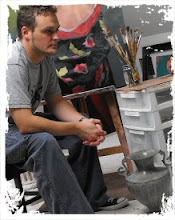 Antonio Mancini
Antonio Mancini (Italian b. 1852, Academic Painter) was born in Rome, Italy in 1852. At twelve, he was accepted into the Institute of Fine Arts "Istituto di Belle Arti" in Naples, where he studied under historical painter Domenico Morelli. Morelli was widely know for his use of energetic brushwork and application of
chiaroscuro

(chiaroscuro: the treatment of dramatic light and shadow in a painting or drawing, an effect of contrasted light and shadow on a subject with a single light source.) Antonio developed rapidly under Morelli, and would soon exhibit two paintings at the Paris Salon at the youthful age of eighteen. In 1873 Mancini graduate from the academy and soon rented a studio in Napels with his friend Vincenzo Gemito.


Most of Mancini's work revolved around paintings of dancers, musicians, circus and street performers, as well as homeless children. His portrait "Saltimbanco" illustrates a young street performer whose life had been spent entertaining crowds.

His painting, "The Poor Schoolboy", exhibited in the Paris Salon of 1876, is in the Musee d'Orsay in Paris. It's realist subject matter and dark palette are typical of his early work. Paintings by Mancini can also be seen in various Italian museums such as Museo Civico-Galleria d'Arte Moderna in Turin and Galleria Nazionale d'Arte Moderna e Contemporanea in Rome.
His first trip to Paris was in 1877 where he was introduced to a number of the French Impressionists including Degas, Manet, as well as portrait painter John Singer Sargent. He later became close friends with Sargent, who called Mancini "the greatest living painter." Sargent became an avid supporter of Mancini's work and often spoke highly of him to gallery owners and collectors. Mancini had a wonderful sense of theatrics about his paintings and "After the duel" is a dramatic example of this sensibility.

Mancini was very much inspired by the Impressionists and thereafter loosened his own brush strokes. His paintings began to take on a brightened palette with a very bold
impasto technique (impasto: a technique used in painting, where paint is laid on an area of the surface very thickly so that the brush or palette-knife strokes are visible. Paint can also be mixed right on the canvas.) The word "impasto" is Italian in origin; meaning "dough" or "mixture"; the verb "impastare" translates variously as "to knead", or "to paste". on canvas.
Mancini employed an unusual grid technique which can be still seen in his work today. This approach was a technique where in which the artist would apply a series of criss-crossing strings or wire to a frame or canvas stretcher. During a sitting, the artist employed 2 of these gridded frames. One frame would then be placed in front of the model while the other was placed directly in front of the artist's canvas thus providing an accurate visual context for deciphering proportions and compositions.

Many of Mancini's paintings display this technique and it is clear that these grids were placed directly on the canvas and then painted upon. Mancini would then remove the grid from
the painting and what
remained was a ghostly indication of these small square sections. Walter Richard Sickert, a mutual friend of both Sargent and Mancini, explained Mancini’s sometimes very unusual method in 1927:
"His paintings were done through a wire grille, whose squares correspond with a grille before the sitter. The marks of the grille remain. The sitter being, as it were, pinned down, retained of his mobility alone the facial expression. But, trembling and snorting within that restriction, there is an extraordinary vivacity, there is power and a dashing impasto."

This method can best be seen in his panting of "de Lafenis". Not only did he employ this unusual technique but he also employed such materials as shards of glass, and foil. This gave the paint more illumination; again, "de Lafenis" is a strong example.

In 1881, Mancini suffered a crippling mental illness. He settled in Rome in 1883 for twenty years and then later relocated to Frascati where he lived until 1918. During this period, Mancini was often very poor and relied upon the help of close friends and art buyers to survive. He struggled financially until a Dutch collector named Hendrik Willem Mesdag became his benefactor and signing him to a artistic contract. After World War I, his living situation improved and his work took on a new found sense of serenity. Antonio Mancini died in Rome in 1930.
The Philadelphia Art Museum currently owns fifteen oil paintings and three pastels by Antonio Mancini. The first American exhibition of Antonio Mancini's work was at the Philadelphia Museum of Art.

Become a follower of this blog by clicking on the link provided to the right hand side. Also, please visit me on Twitter at http://twitter.com/wseccombe or visit my website www.williamseccombe.com. Thank you.
Billy Seccombe
www.billyseccombe.om
https://twitter.com/wseccombe
Bibliography Sources:
www.wikipedia.org
www.artcyclopedia.com
www.jssgallery.org
www.nytimes.com
www.philamuseum.org























































